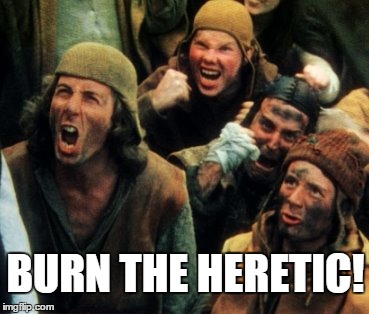


Similarly, there were always groups of people who had unusual religious beliefs and practices, which could be interpreted as ‘heresy’. Witch hunters and magistrates interpreted such stories as evidence of the Satanic activity in which they believed. This was a fantasy, dreamed up by scholars, churchmen, lawyers and others, but it was based on reality to the extent that in every small community, quarrels, rivalries, jealousies and so on are expressed through allegations that some people are using magical powers to harm their neighbours. In the case of witches, between the 15th and 18th centuries people were put to death all over Europe, usually by burning, on the basis of a belief that they were agents and worshippers of the devil.

Q: Is heresy comparable to the witch craze?Ī: Yes – no one now believes there’s any basis in the fear of witches. I argue that this idea of there being a link between heretics in this region and the rest of Europe is complete fantasy and nonsense. Why does that matter? Because if you simply call all heretics Cathars then you are implying that they are part of a European-wide movement – an ‘anti-church’ group pitted against the Roman church. There is a disagreement between historians about whether it’s right to call these people Cathars. īut people who were called heretics were not called Cathars in the Middle Ages. There is no indication that they did not get on and coexist with Catholics until outsiders such as crusaders and inquisitors came in.įor example, the 20-year Albigensian crusade, which began in 1209, was accompanied and followed up by persecution.Ī: If you visit the south of France today, you’ll see there’s huge tourist activity that rotates around the word ‘Cathars’. The usual assumption is that the Middle Ages was the ‘age of faith’, when people hated heretics. That’s where they came into conflict with the church.Ī: This changed over time. They placed high value on chastity, and were opposed to any ostentatious wealth and to the wealth and power structure of the church. Most heretics – the ones we can identify, that is – tended to believe a very simple form of Christianity, based on literal readings of the New Testament. There is a widely held assumption that heretics who were burned in southern France were part of a Europe-wide heretic movement, who believed there were two gods: one good, and one evil.īut this is not my view – I will be expanding on this in my lecture. That gives you an idea of the scale.Ī: Every group believed different things. Q: How many people were burned for being heretics?Ī: Again, impossible to say, but we do know that on many occasions heretics were burned in large groups – sometimes 200 at a time. And they would have been alleged to be leaders of heretic groups.įrom then onwards, you start to see ordinary people being put to death too. In 1022, people who were considered heretics were burned for the first time since antiquity.Ī: It’s impossible to group them over such a huge time period, but until around 1160 only a small number were put to the stake.

A: Heresy was an opinion about the teaching of the Catholic church, which was condemned by the church as inconsistent with it.įrom the early 11th century, many people accused of heresy were burned at the stake as a result.


 0 kommentar(er)
0 kommentar(er)
